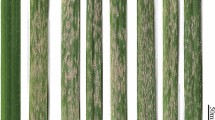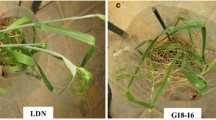Abstract
Powdery mildew is a severe disease in wheat. In barley, durable resistance exists, based on non-functionality of the Mlo gene. As a model to analyse the effects of mutagenesis in the homoeologous Mlo genes of wheat, we developed mlo-based powdery mildew resistance in tetraploid durum wheat. To obtain Mlo mutations, we screened a TILLING population developed in tetraploid wheat “Kronos” for which the captured exome sequence of > 1500 lines is available. This resulted in 23 mutants for Mlo-A1 and 26 non-redundant mutants for Mlo-B1. Two Mlo-A1 and four Mlo-B1 mutants were crossed to obtain eight F2 mutant lines that showed a range of phenotypes from susceptibility to full resistance. Pot experiments under semi-field conditions confirmed the resistance levels for six of the mutants without any signs of adverse pleiotropic effects. Resistance ranking was similar across six powdery mildew isolates, indicating no isolate specificity of the mlo-based resistance. The effect of mutations in the Mlo-B1 gene was stronger than in the Mlo-A1 gene, probably reflecting differences in wild-type Mlo gene expression levels. Strong partial resistance effects were observed with single mlo-B1 mutations hence, revealing a dosage effect of mlo mutant alleles. Two of the four mlo-B1 mutations (W163* and P335L) were very strong; however, the highest combined effect was observed with the MloA-P335S/MloB-P335L combination, suggesting that non-functional, but full-length Mlo proteins might have the strongest effect compared with nonsense mutations. Our results show that mlo-based resistance might offer possibilities to introduce durable protection in tetraploid wheat against powdery mildew.




Similar content being viewed by others

References
Acevedo-Garcia J, Spencer D, Thieron H, Reinstädler A, Hammond-Kosack K, Phillips AL, Panstruga R (2017) mlo-based powdery mildew resistance in hexaploid bread wheat generated by a non-transgenic TILLING approach. Plant Biotechnol J 15:367–378
Aist JR, Gold RE, Bayles CJ, Morrison GH, Chandra S, Israel HW (1988) Evidence that molecular components of papillae may be involved in ml-o resistance to barley powdery mildew. Physiol Mol Plant Pathol 33:17–32
Ben-David R, Peleg Z, Dinoor A, Saranga Y, Korol AB, Fahima T (2014) Genetic dissection of quantitative powdery mildew resistance loci in tetraploid wheat. Mol Breeding 34:1647–1658
Bengtsson T, Åhman I, Manninen O, Reitan L, Christerson T, Due Jensen J, Krusell L, Jahoor A, Orabi J (2017) A novel QTL for powdery mildew resistance in nordic spring barley (Hordeum vulgare L. ssp. vulgare) revealed by genome-wide association study. Frontiers in Plant Science 8
Bennett FGA (1984) Resistance to powdery mildew in wheat: a review of its use in agriculture and breeding programmes. Plant Pathol 33:279–300
Borrill P, Adamski N, Uauy C (2015) Genomics as the key to unlocking the polyploid potential of wheat. New Phytol 208:1008–1022
Büschges R, Hollricher K, Panstruga R, Simons G, Wolter M, Frijters A, van Daelen R, van der Lee T, Diergaarde P, Groenendijk J, Töpsch S, Vos P, Salamini F, Schulze-Lefert P (1997) The barley Mlo gene: a novel control element of plant pathogen resistance. Cell 88:695–705
Cerón MMC, Martel IS (2003) Effects of powdery mildew severity (Blumeria graminis f.sp. tritici) severity on breeding lines of durum wheat (Triticum turgidum L. spp. durum) yield in western Andalusia. Span J Agric Res 1:13–18
Devoto A, Hartmann HA, Piffanelli P, Elliott C, Simmons C, Taramino G, Goh C-S, Cohen FE, Emerson BC, Schulze-Lefert P, Panstruga R (2003) Molecular phylogeny and evolution of the plant-specific seven-transmembrane MLO family. J Mol Evol 56:77–88
Elliott C, Zhou F, Spielmeyer W, Panstruga R, Schulze-Lefert P (2002) Functional conservation of wheat and rice Mlo orthologs in defense modulation to the powdery mildew fungus. Mol Plant Microbe Interact 15:1069–1077
Elliott C, Muller J, Miklis M, Bhat RA, Schulze-Lefert P, Panstruga R (2005) Conserved extracellular cysteine residues and cytoplasmic loop-loop interplay are required for functionality of the heptahelical MLO protein. Biochem J 385:243–254
Ge X, Deng W, Lee ZZ, Lopez-Ruiz FJ, Schweizer P, Ellwood SR (2016) Tempered mlo broad-spectrum resistance to barley powdery mildew in an Ethiopian landrace. Sci Rep 6:29558
Jørgensen IH (1992) Discovery, characterization and exploitation of Mlo powdery mildew resistance in barley. Euphytica 63:141–152
Jørgensen JH, Mortensen K (1977) Primary infection by Erysiphe graminis f. sp. hordei of barley mutants with resistance genes in the ml-o locus. Phytopathology 67:678–685
Kjær B, Jensen HP, Jensen J, Jørgensen JH (1990) Associations between three ml-o powdery mildew resistance genes and agronomic traits in barley. Euphytica 46:185–193
Krasileva KV, Vasquez-Gross HA, Howell T, Bailey P, Paraiso F, Clissold L, Simmonds J, Ramirez-Gonzalez RH, Wang X, Borrill P, Fosker C, Ayling S, Phillips AL, Uauy C, Dubcovsky J (2017) Uncovering hidden variation in polyploid wheat. Proc Natl Acad Sci 114:E913–E921
Kusch S, Panstruga R (2017) mlo-based resistance: an apparently universal “weapon” to defeat powdery mildew disease. Mol Plant Microbe Interact 30:179–189
Lundqvist U, Meyer J, Lundqvist A (1991) Mutagen specificity for 71 lines resistant to barley powdery mildew race D1 and isolated in 4 highbred barley varieties. Hereditas 115:227–239
Mangiafico, SS (2016) Summary and analysis of extension program evaluation in R, version 1.15.0. rcompanion.org/handbook/
McGrann GRD, Stavrinides A, Russell J, Corbitt MM, Booth A, Chartrain L, Thomas WTB, Brown JKM (2014) A trade off between mlo resistance to powdery mildew and increased susceptibility of barley to a newly important disease, Ramularia leaf spot. J Exp Bot 65:1025–1037
Müller J, Piffanelli P, Devoto A, Miklis M, Elliott C, Ortmann B, Schulze-Lefert P, Panstruga R (2005) Conserved ERAD-like quality control of a plant polytopic membrane protein. Plant Cell 17:149–163
Nyikó T, Kerényi F, Szabadkai L, Benkovics AH, Major P, Sonkoly B, Mérai Z, Barta E, Niemiec E, Kufel J, Silhavy D (2013) Plant nonsense-mediated mRNA decay is controlled by different autoregulatory circuits and can be induced by an EJC-like complex. Nucleic Acids Res 41:6715–6728
Pearce S, Vazquez-Gross H, Herin SY, Hane D, Wang Y, Gu YQ, Dubcovsky J (2015) WheatExp: an RNA-seq expression database for polyploid wheat. BMC Plant Biol 15:299
Reinstadler A, Muller J, Czembor J, Piffanelli P, Panstruga R (2010) Novel induced mlo mutant alleles in combination with site-directed mutagenesis reveal functionally important domains in the heptahelical barley Mlo protein. BMC Plant Biol 10:31
Sim N-L, Kumar P, Hu J, Henikoff S, Schneider G, Ng PC (2012) SIFT web server: predicting effects of amino acid substitutions on proteins. Nucleic Acids Res 40:W452–W457
Skou JP (1982) Callose formation responsible for the powdery mildew resistance in barley with genes in the ml-o Locus. J Phytopathol 104:90–95
Skou JP, Jørgensen JH, Lilholt U (1984) Comparative studies on callose formation in powdery mildew compatible and incompatible barley. J Phytopathol 109:147–168
Stolzenburg MC, Aist JR, Israel HW (1984) The role of papillae in resistance to powdery mildew conditioned by the ml-o gene in barley I correlative evidence. Physiol Plant Pathol 25:337–346
R Core Team (2017). R: A language and environment for statistical computing. R Foundation for Statistical Computing, Vienna, Austria. URL https://www.R-project.org/
Uauy C, Paraiso F, Colasuonno P, Tran RK, Tsai H, Berardi S, Comai L, Dubcovsky J (2009) A modified TILLING approach to detect induced mutations in tetraploid and hexaploid wheat. BMC Plant Biol 9:115
Uauy C, Wulff BBH, Dubcovsky J (2017) Combining traditional mutagenesis with new high-throughput sequencing and genome editing to reveal hidden variation in polyploid wheat. Annu Rev Genet 51:435–454
Várallyay É, Giczey G, Burgyán J (2012) Virus-induced gene silencing of Mlo genes induces powdery mildew resistance in Triticum aestivum. Arch Virol 157:1345–1350
Wang Y, Cheng X, Shan Q, Zhang Y, Liu J, Gao C, Qiu J-L (2014) Simultaneous editing of three homoeoalleles in hexaploid bread wheat confers heritable resistance to powdery mildew. Nat Biotechnol 32:947
Zierold U, Scholz U, Schweizer P (2005) Transcriptome analysis of mlo-mediated resistance in the epidermis of barley. Mol Plant Pathol 6:139–151
Acknowledgements
This work was supported by GUDP (under the Ministry of Environment and Food of Denmark), Sejet Plant Breeding, Pajbjergfonden, and Aarhus University.
Author information
Authors and Affiliations
Corresponding author
Ethics declarations
Conflict of interest
On behalf of all authors, the corresponding author states that there is no conflict of interest.
Additional information
Communicated by Albrecht E. Melchinger.
Publisher's Note
Springer Nature remains neutral with regard to jurisdictional claims in published maps and institutional affiliations.
Electronic supplementary material
Below is the link to the electronic supplementary material.
Rights and permissions
About this article
Cite this article
Ingvardsen, C.R., Massange-Sánchez, J.A., Borum, F. et al. Development of mlo-based resistance in tetraploid wheat against wheat powdery mildew. Theor Appl Genet 132, 3009–3022 (2019). https://doi.org/10.1007/s00122-019-03402-4
Received:
Accepted:
Published:
Issue Date:
DOI: https://doi.org/10.1007/s00122-019-03402-4



